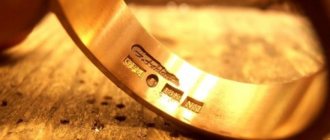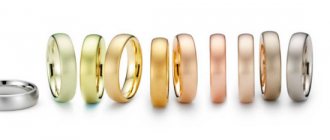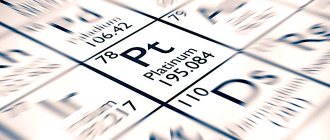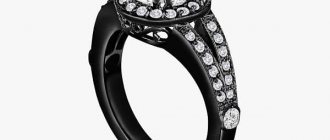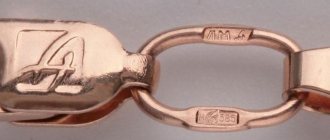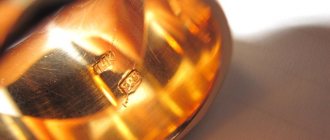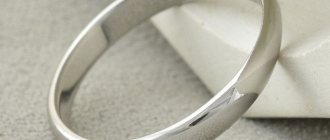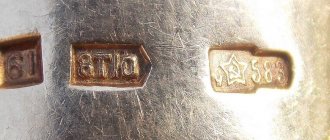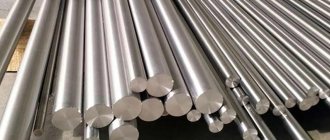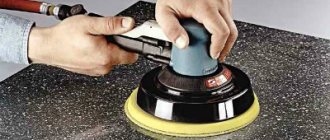| Rhodium | |
| Atomic number | 45 |
| Appearance of a simple substance | silver-white hard metal |
| Properties of the atom | |
| Atomic mass (molar mass) | 102.9055 a. e.m. (/mol) |
| Atomic radius | 134 |
| Ionization energy (first electron) | 719.5 (7.46) kJ/mol () |
| Electronic configuration | [Kr] 4d8 5s1 |
| Chemical properties | |
| Covalent radius | 125 pm |
| Ion radius | (+3e)68 pm |
| Electronegativity (Pauling) | 2,28 |
| Electrode potential | 0 |
| Oxidation states | 5, 4, 3, 2, 1, 0 |
| Thermodynamic properties of a simple substance | |
| Density | 12.41 g/cm³ |
| Molar heat capacity | 24.95 J/(K mol) |
| Thermal conductivity | 150 W/(m K) |
| Melting temperature | 2239 K |
| Heat of Melting | 21.8 kJ/mol |
| Boiling temperature | 4000 K |
| Heat of vaporization | 494 kJ/mol |
| Molar volume | 8.3 cm³/mol |
| Crystal lattice of a simple substance | |
| Lattice structure | cubic face-centered |
| Lattice parameters | a=3.803 Å |
| c/a ratio | — |
| Debye temperature | 480K |
| Rh | 45 |
| 102,9055 | |
| [Kr]4d85s1 | |
| Rhodium | |
Rhodium
- an element of the side subgroup of the eighth group of the fifth period of the periodic system of chemical elements, atomic number 45. Denoted by the symbol Rh (Latin Rhodium). The element rhodium (CAS number: 7440-16-6) is a hard, silvery-white transition metal. A noble metal of the platinum group.
Physical properties
Rhodium foil and wire
Rhodium is a hard metal, silver-gray in color. It has a high reflectivity of electromagnetic rays of the visible part of the spectrum, therefore it is widely used for the manufacture of “surface” mirrors.
Isotopes of rhodium
Natural rhodium consists of the isotope 103Rh. Longest-lived isotopes
| Isotope | Half life |
| 101Rh | 3.3 years |
| 102Rh | 207 days |
| 102mRh | 2.9 years |
| 99Rh | 16.1 days |
Deposits, extraction methods
Until the beginning of the third millennium, the “custodian” of most ore reserves was Russia with gigantic deposits of native platinum in the Urals and the Arctic.
Today, Mexico holds the lead in reserves (43%), whose golden sands are oversaturated with rhodium. Next come the deposits of South Africa, Colombia, and the USA.
The annual global production of rhodium does not exceed 31 tons.
The number one metal exporter (80% of volumes) is South Africa.
Rhodium is mined on an industrial scale using a closed (mine) method. It is complicated by the composition of the ore: the metal is mixed with gold, palladium, platinum and silver.
Chemical properties
Rhodium is a noble metal; its chemical resistance in most corrosive environments is superior to platinum. Metallic rhodium dissolves in aqua regia when boiled, as well as electrochemically, anodically - in a mixture of hydrogen peroxide and sulfuric acid.
Rhodium is characterized by high chemical resistance. It interacts with non-metals only at red heat temperatures. Finely ground rhodium slowly oxidizes only at temperatures above 600°C:
4Rh + 3O2 = 2Rh2O3.
When heated, rhodium slowly reacts with concentrated sulfuric acid, a solution of sodium hypochlorite and hydrogen bromide. During sintering, it reacts with molten potassium hydrogen sulfate KHSO4, sodium peroxide Na2O2 and barium peroxide BaO2:
2Rh + 6KHSO4 = 2K3Rh(SO4)3 + 3H2↑,
2Rh + 3BaO2 = Rh2O3 + 3BaO.
In the presence of alkali metal chlorides, when it is possible to form [RhX3]3- complexes, rhodium reacts with chlorine, for example:
2Rh + 6NaCl + Cl2 = 2Na3[RhCl6].
When aqueous solutions of rhodium(III) salts and complexes are exposed to alkalis, a precipitate of rhodium hydroxide Rh(OH)3 is formed:
Na3[RhCl6] + 3NaOH = Rh(OH)3↓ + 6NaCl.
Rhodium(III) hydroxide and oxide exhibit basic properties and react with acids to form Rh(III) complexes:
Rh2O3 + 12HCl = 2H3RhCl6 + 3H2O,
Rh(OH)3 + 6HCl = H3RhCl6 + 3H2O.
Rhodium exhibits the highest oxidation state +6 in the hexafluoride RhF6, which is formed by direct combustion of rhodium in fluorine. The connection is unstable. In the absence of water vapor, hexafluoride oxidizes free chlorine or nitrogen oxide (II) NO:
2RhF6 + 3Cl2 = 2RhF3 + 6ClF.
In the lower oxidation states +1 and +2, rhodium forms complex compounds.
History of discovery
Initially, the metal was considered a waste product, a by-product of platinum production.
The first to become interested in it was in 1803 the British chemist William Wollaston.
He examined platinum from the mines of South America, performing a series of experiments:
- After dissolving the samples with aqua regia, the liquid turned pink-reddish.
- When platinum and palladium precipitated, a purplish powder formed.
- It was fried in hydrogen.
The result was a massive grayish powder.
Application
Catalysts
- Rhodium is used in catalysts, including catalytic filter-neutralizers for automobile exhaust gases
- The rhodium-platinum alloy is a very effective catalyst for the production of nitric acid by the oxidation of ammonia with air, and there is still no alternative replacement for its use.
Construction material
- in glass production (platinum-rhodium alloy - dies for glass filaments, for liquid crystal screens). Due to the growth in the production of liquid crystal devices, the consumption of rhodium is growing rapidly (in 2005, 1.55 tons of rhodium were used in glass production, in 2003 - 0.81 tons).
- Metallic rhodium is used for the production of mirrors subjected to strong heating (incandescence) for high-power laser systems (for example, hydrogen fluoride lasers), as well as for the production of diffraction gratings for devices for analyzing substances (spectrometers).
- Platinum-rhodium alloy crucibles are used in laboratory research and for growing some gemstones and electro-optical crystals.
Thermocouple
- Platinum-rhodium thermocouples, etc., rhodium-iridium alloys (for example IR 40\60) are widely used as very effective and durable measurements of high (up to 2200 °C) temperatures.
Contact pair material
Due to its high resistance to electrical erosion, rhodium and its alloys are used as a material for contacts (reed switches, connectors, sliding contacts).
Jewelry
Galvanic rhodium plating electrolytes (mainly sulfate, sulfamate and phosphate) are used to obtain wear-resistant and corrosion-resistant coatings.
The cool white shine of rhodium goes well with diamonds, cubic zirconia and other inserts. Rhodium is also added as an alloying and strengthening additive to platinum and palladium. Applying rhodium plating to jewelry reduces wear and increases the hardness of the piece, protects it from scratches, and adds a bright shine.
Extracting rhodium
Obtaining a rare platinum compound, such as iron, for example, is impossible. First, you will have to extract platinum ore and take it to the processing plant. There the platinum is separated from the waste rock. The platinum is then sent for refining—the “refining” of the resulting platinum. Now you can begin the actual mining of rhodium. The process is complex and long. The solutions from the refining undergo several chemical reactions, then the resulting substance is calcined to obtain pure rhodium.
Interesting: technology is being developed for extracting metal from radioactive waste. The technology is attractive: the amount of radioactive waste will be reduced (a plus for the environment). In addition, some analysts believe that the extraction of rhodium from nuclear power plant waste will exceed standard metal extraction.
Prices
In February 2006, rhodium prices reached a record high of $3,500 per troy ounce according to kitco.com/charts/rhodium.html. In January 2008, rhodium prices set a new record of $7,000 per ounce. After peaking at $10,100 per ounce, the price of rhodium fell to $900 at the end of November 2008 due to the crisis in the automotive industry. On November 19, 2009, the price of the metal rose to $2,600 per ounce. Due to very high prices for pure rhodium and with significant demand and a small volume of mined rhodium, an urgent task arises to solve the acute shortage of rhodium, isolating its stable isotope from fission fragments of nuclear fuel (uranium, plutonium, thorium), where it accumulates in significant quantities. quantities (up to 130-180 grams per ton of fragments), and taking into account the developed nuclear energy in the largest industrial countries, the volume of production of reactor rhodium will be several times higher than its production from ores. In addition, research is also needed on the issue of reactor operating modes, in which the amount of rhodium as a percentage of the mass of fragments will be higher, and thus the nuclear industry can become the main supplier of rhodium to the world market.
Look for Rhodium in Platinum
Rhodium, unlike many metals, does not have deposits with industrial mineralization. The rare metal is extracted from platinum ores, gold-bearing placer deposits, and native platinum. In copper-nickel ores, the content of rare platinum is negligible - a few milligrams per ton of ore.
Informative: there is a mineral where the share of rhodium is 11.3%. This is native Nevyanskite. A reason for pride - it was discovered by attentive, inquisitive mining workers of the Urals, not far from the city of Nevyansk.
Platinoids
Platinoids are the names of 6 metals that are part of a single platinum group. Its composition includes palladium, ruthenium, rhodium, iridium, platinum, osmium. They all have similar chemical and physical properties, and are often found in the same natural deposits.
Today, each of the metals in this group is used to a greater or lesser extent in the production of jewelry. Previously, they were used in ancient Russia to produce coins. In the 1970s, these metals were used in the production of automobiles.
How to care for rhodium plated jewelry?
To preserve the product in its original form, it is worth understanding: rhodium plating means that the product is coated with a very thin layer of metal that can wear off. Therefore, if you get into your hands any materials that are aggressive towards rhodium, for example, sandpaper or chemicals (powder), then it is better to remove the product from your hand, if it is a ring or bracelet.
There are tips that experts always give in order to protect your jewelry from damage:
- Do not clean metal with toothpaste or tooth powder. It is also worth protecting from ammonia-containing products;
- It is advisable to remove the jewelry before going to bed or going to the bathhouse;
- if any alcohol-containing substances have been applied to the skin, the product can be put on only after they have been absorbed;
- Rhodium plating should not be exposed to chemicals;
- to clean valuables, you should use warm water and a special jewelry napkin in order to polish the surface well;
- It is advisable to have your jewelry polished by professionals once every few years. They will clean it, adhering to all the rules, and also, if necessary, re-rhodium.
If you follow these simple rules, your jewelry will always have a fresh and aesthetic appearance.
Receipt
Rhodium is extracted from native platinum. Raw native platinum is placed in porcelain cauldrons, after which it is treated with aqua regia while heating for 24 hours. Rhodium, almost all platinum, palladium, base metals (iron, copper and others), partially ruthenium and iridium go into solution, and osmide iridium, quartz, chromium iron ore and other impurities remain in the sediment. The remaining solution is evaporated, up to 6% rhodium remains in the sediment; palladium, ruthenium, iridium, platinum are also present (all of it cannot be separated using NH 4 Cl) and base metals. This precipitate is dissolved in water and the platinum is separated again in the same way. The solution, in which rhodium, ruthenium and palladium remain, is sent for purification and separation.
Rhodium is extracted in different ways. There is a known method proposed by the Soviet scientist V.V. Lebedinsky in 1932. First, the solution is treated with sodium nitrite NaNO 2. In this way, base metal hydroxides are precipitated and separated from the solution. Rhodium is retained in solution in the form of Na 3 [Rh(NO 2 )6 ]. After this, by the action of NH 4 Cl on the solution in the cold, rhodium is released in the form of a poorly soluble complex (NH 4 )2 Na[Rh(NO 2 )6 ]. However, in this case, along with rhodium, iridium also precipitates. The other platinum metals—ruthenium, palladium, and residual platinum—remain in solution.
The precipitate is treated with diluted sodium hydroxide, which allows it to dissolve. Rhodium is again precipitated from the resulting solution by the action of ammonia and NH 4 Cl. Precipitation occurs due to the formation of a poorly soluble complex compound [Rh(NH 3 )3 (NO 2 )3]. The separated precipitate is thoroughly washed with ammonium chloride solution. After this, the precipitate is treated with hydrochloric acid, heating it in it for several hours. The reaction occurs:
2[Rh(NH 3 )3 (NO 2 )3 ] + 6HCl → 2[Rh(NH 3 )3 Cl 3 ] +3NO 2 + 3NO + 3H 2 O
with the formation of triamine rhodium trichloride of a bright yellow color. The precipitate is thoroughly washed with water, transforming it into a state suitable for the isolation of metallic rhodium. The resulting compound is calcined for several hours at 800–900 °C. The result of the process is a powdery product of a mixture of rhodium and its oxides. The powder is cooled, washed with diluted aqua regia to remove the remaining small amount of base impurities, and then at high temperature it is reduced to metal in a hydrogen environment.
Rhodium plating technology
Due to its special, pleasant silver-white hue and amazing reflectivity, the element is very much in demand by jewelers. Rhodium plating allows not only to impart a brilliant platinum shimmer, but also to increase the strength of products and their resistance to scratches. The application process is a lengthy procedure that requires preliminary preparation.
Before coating, the jewelry is polished until there is no evidence left on the metal surface that it has already been worn. The next stage is degreasing and disinfection. After this, it is sent to a galvanic bath, where a rhodium layer is applied.
A solution containing positively charged particles of metal salts is first poured into a special container. In this case, the object itself is charged with negative particles. An electric charge is supplied through it, as a result of which opposite particles are attracted to each other. The jewelry itself acts as an anode and, at the moment of current action, is completely covered and disappears under the rhodium. The longer and more intense the charge is applied, the thicker the coating becomes.
Several years ago, the main element used in this technology was rhodium salts. However, due to the difficulty of their extraction, in our time they have been replaced by rhodium sulfate, which is produced specifically for creating a coating on products.
Despite its fairly high strength, the coating layer applied to jewelry can be damaged during cleaning using abrasives. Therefore, it is better to take them off to maintain a flawless appearance. To care for such items, you can use soft wet wipes . It should be remembered that the rhodium plating procedure is a temporary measure, so there may be a need for repeated processing.
Recommendations
- Mejia, Juris; and others. (2016). "Atomic Weight of Elements 2013 (IUPAC Technical Report)". Pure and applied chemistry
.
88
(3):265–91. doi:10.1515/pac-2015-0305. - Ellis J. Highly reduced carbonyl metal anions: synthesis, characterization and chemical properties. Adv. Organomet. Chem, 1990, 31: 1-51.
- "Rhodium: evidence from a rhodium(I) fluoride compound". OpenMOPAC.net. Retrieved December 10, 2007.
- Leede, D. R., ed. (2005). "Magnetic susceptibility of elements and inorganic compounds." CRC Handbook of Chemistry and Physics
(PDF) (86th ed.). Boca Raton (FL): CRC Press. ISBN 0-8493-0486-5. - Weast, Robert (1984). CRC, Handbook of Chemistry and Physics
. Boca Raton, FL: Chemical Rubber Company Publishing. page E110. ISBN 0-8493-0464-4. - Armin Fehn and Jürgen Weidinger, Wacker Chemie AG, US Patent US7129309B2
- Wollaston, W. H. (1804). "On a new metal found in raw platinum." Philosophical Transactions of the Royal Society of London
.
94
: 419–430. Doi:10.1098 / rstl.1804.0019. - Griffith, W. P. (2003). "Rhodium and palladium - events associated with its discovery." Review of Platinum Metals
.
47
(4): 175–183. - Wollaston, W. H. (1805). “On the discovery of palladium; with observations of other substances found with platinum." Philosophical Transactions of the Royal Society of London
.
95
: 316–330. Doi:10.1098 / rstl.1805.0024. - Usselman, Melvin (1978). "The Wollaston and Chenevix Controversy over the Elementary Nature of Palladium: A Curious Episode in the History of Chemistry." Annals of Science
.
35
(6):551–579. Doi:10.1080/00033797800200431. - Leede, David R. (2004). CRC Handbook of Chemistry and Physics: A Complete Reference Book of Chemical and Physical Data
. Boca Raton: CRC Press. pp.4–26. ISBN 978-0-8493-0485-9. - Greenwood, Norman N.; Earnshaw, Alan (1997). Chemistry of elements
(2nd ed.). Butterworth-Heinemann. item 1113. ISBN 978-0-08-037941-8. - Griffith, W. P. (2003). "Bicentenary of the four platinum group metals: osmium and iridium - events associated with their discoveries." Review of Platinum Metals
.
47
(4): 175–183. - Hulett, G.A.; Berger, H. W. (1904). "Platinum volatilization." Journal of the American Chemical Society
.
26
(11): 1512–1515. Doi:10.1021/ja02001a012. - Measurement, ASTM Committee E.2.0. by temperature (1993). "Platinum type". A Guide to Using Thermocouple in Temperature Measurement
.
ASTM Special Technical Publication
. ASTM International. Bibcode:1981mutt.book….. B. ISBN 978-0-8031-1466-1. - J. W. Pierce, F. Edler, K. J. Elliott, A. Greenen, P. Harris, C. Izquierdo, Y. Kim, M. J. Martin, I. M. Smith, D. Tucker, and R. I. Veicheva, Systematic study of the thermoelectric stability of Pt-Rh thermocouples between 1300 and 1500 degrees Celsius, METROLOGY, 2022, Volume: 55 Issue: 4 Pages: 558- 567
- Kushner, Joseph B. (1940). "Modern rhodium plating." Metals and alloys
.
11
: 137–140. - Amatayakul, W.; Ramnas, Olle (2001). "Life Cycle Assessment of a Passenger Car Catalytic Converter." Journal of Cleaner Production
.
9
(5): 395. doi:10.1016/S0959-6526(00)00082-2. - Heck, R.; Farrauto, Robert J. (2001). "Car Emission Catalysts". Applied Catalysis A: General
.
221
(1–2):443–457. Doi:10.1016/S0926-860X(01)00818-3. - Heck, R.; Gulati, Suresh; Farrauto, Robert J. (2001). "Application of monoliths for gas-phase catalytic reactions". Journal of Chemical Engineering
.
82
(1–3): 149–156. Doi:10.1016/S1385-8947 (00)00365-X. - ^ a b
Kramer, Stephen D.;
Covino Jr., Bernard S., eds. (1990). ASM Handbook
. Materials Park, Ohio: ASM International. pp. 393–396. ISBN 978-0-87170-707-9. - Emsley, John (2001). The Building Blocks of Nature
((Hardcover, First Edition) ed.). Oxford University Press. item 363. ISBN 978-0-19-850340-8. - Holleman, Arnold F.; Wiberg, Egon; Wiberg, Nils (1985). Lehrbuch der Anorganischen Chemie
(91–100 ed.). Walter de Gruyter. pp. 1056–1057. ISBN 978-3-11-007511-3. - Reisner, B.A.; Stacey, A. M. (1998). "Sr 3ARXO 6 (A = Li, Na): crystallization of rhodium(V) oxide from molten hydroxide." Journal of the American Chemical Society
.
120
(37):9682–9989. Doi:10.1021/ja974231q. - Griffith, W. P. The Rarer Platinum Metals
, John Wiley and Sons: New York, 1976, p. 313. - Osborne, J. A.; Jardine, F. H.; Young, J.F.; Wilkinson, G. (1966). "Preparation and properties of tris(triphenylphosphine)halogenorhodium(I) and some of its reactions, including the catalytic homogeneous hydrogenation of olefins and acetylenes and their derivatives." Journal of the Chemical Society A
: 1711–1732. doi:10.1039/J19660001711. - Audi, Georges; Bersillon, Olivier; Blachot, Jean; Wapstra, Aldert Hendrik (2003), “ThenUBASE Estimation of Nuclear and Decay Properties,” Nuclear Physics A
,
729
: 3–128, Bibcode:2003NuFA.729…. 3A, doi:10.1016/j.nuclphysa.2003.11.001 - David R. Leed (ed.), Norman E. Holden in CRC Handbook of Chemistry and Physics, 85th Edition
CRC Press. Boca Raton, Florida (2005). Section 11, Table of Isotopes. - Barbalas, Kenneth "Table of the Elements." EnvironmentalChemistry.com; received April 14, 2007."
- D. E. Ryan, J. Holtzbecher, R. R. Brooks, Chemical Geology, Volume 85, Issues 3–4, July 30, 1990, Pages 295-303
- Orecchio and Amorello, Food, 2022, volume 8, issue 2, Doi: 10.3390/foods8020059
- ^ a b
Loferski, Patricia J. (2013). "Commodity Report: Platinum Group Metals" (PDF). US Geological Survey. Retrieved July 16, 2012. - «Rhodiumpreis aktuell in euros and dollars | Rhodium | Rhodiumkurs. finanzen.net
. - Kolarik, Zdenek; Renard, Edouard V. (2005). "Possible industrial applications of fission platinoids" (PDF). Review of Platinum Metals
.
49
(2): 79. doi:10.1595/147106705X35263. - Kolarik, Zdenek; Renard, Edouard V. (2003). “Recovery of valuable fission platinoids from spent nuclear fuel. Part I PART I: General considerations and fundamentals of chemistry" (PDF). Review of Platinum Metals
.
47
(2): 74–87. - Kolarik, Zdenek; Renard, Edouard V. (2003). “Recovery of valuable fission platinoids from spent nuclear fuel. Part II: The Separation Process" (PDF). Review of Platinum Metals
.
47
(2): 123–131. - Shelef, M.; Graham, G. W. (1994). “Why is rhodium in automotive three-way catalysts?” Catalysis Reviews
.
36
(3):433–457. Doi:10.1080/01614949408009468. - Roth, James F. (1975). "Rhodium-catalyzed carbonylation of methanol" (PDF). Review of Platinum Metals
.
19
(1 January): 12–14. - Haidingsfeldova, M., & Chapka, M. (2003). "Rhodium complexes as catalysts for hydrosilylation cross-linking of silicone rubber". Journal of Applied Polymer Science
.
30
(5): 1837. doi:10.1002/app.1985.070300505. - Halligudi, S. B.; and others. (1992). "Hydrogenation of benzene to cyclohexane catalyzed by a rhodium(I) complex supported on montmorillonite clay." Reaction kinetics and letters of catalysis
.
48
(2): 547. Bibcode:1992RKCL ... 48..505T. Doi:10.1007/BF02162706. S2CID 97802315. - Akutagawa, S. (1995). "Asymmetric synthesis on BINAP metal catalysts". Applied Catalysis A: General
.
128
(2): 171. doi:10.1016/0926-860X(95)00097-6. - Fischer, Torkel; Fregert, S.; Gruvberger, B.; Rystedt, I. (1984). "Contact sensitivity to nickel in white gold." Contact dermatitis
.
10
(1): 23–24. Doi:10.1111/j.1600-0536.1984.tb00056.x. PMID 6705515. - "Hit & Run: Voice the Changes." Independent
. London. December 2, 2008. Retrieved June 6, 2009. - Leede, David R. (2004). Handbook of Chemistry and Physics CRC 2004–2005: A ready-made reference book of chemical and physical data.
(85th ed.). Boca Raton: CRC Press. pp. 4–26. ISBN 978-0-8493-0485-9. - Weisberg, Alfred M. (1999). "Rhodium plating." Metal finish
.
97
(1):296–299. Doi:10.1016/S0026-0576(00)83088-3. - Smith, Warren J. (2007). "Reflectors". Modern Optical Engineering: Design of Optical Systems
. McGraw-Hill. pp. 247–248. ISBN 978-0-07-147687-4. - McDonagh, S. P.; and others. (1984). "Optimal X-ray spectra for mammography: selection of K-edge filters for tungsten anode tubes." Phys.
Med. Biol .
29
(3): 249–52. Bibcode:1984PMB…. 29..249M. Doi:10.1088/0031-9155/29/3/004. PMID 6709704. - Sokolov, A.P.; Pochivalin, G.P.; Shipovskikh, Yu. M.; Garusov, Yu. V.; Chernikov, O.G.; Shevchenko, V. G. (1993). "Rhodium self-contained detector for monitoring neutron fluence, energy production and fuel isotopic composition." Atomic Energy
.
74
(5): 365–367. Doi:10.1007/BF00844622. S2CID 96175609. - Stwertka, Albert. A Guide to the Elements
, Oxford University Press, 1996, p. 125. ISBN 0-19-508083-1 - "Material Safety Data Sheet - 357340." www.sigmaaldrich.com
. - Leikin, Jerrold B.; Paloucek Frank P. (2008). Handbook of Poisoning and Toxicology
. Informa Health Care. item 846. ISBN 978-1-4200-4479-9. - Landolt, Robert R.; Burke Harold W.; Russell, Henry T. (1972). "Studies on the toxicity of rhodium trichloride in rats and rabbits." Toxicology and applied pharmacology
.
21
(4):589–590. Doi:10.1016/0041-008X (72) 90016-6. PMID 5047055. - "CDC - NIOSH Pocket Guide to Chemical Hazards - Rhodium (Metal Vapors and Insoluble Compounds as Rh)." www.cdc.gov
. Retrieved November 21, 2015. - "CDC - NIOSH Pocket Guide to Chemical Hazards - Rhodium (Soluble Compounds as Rh)." www.cdc.gov
. Retrieved November 21, 2015.
